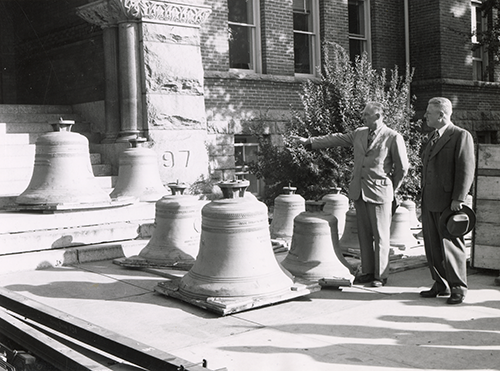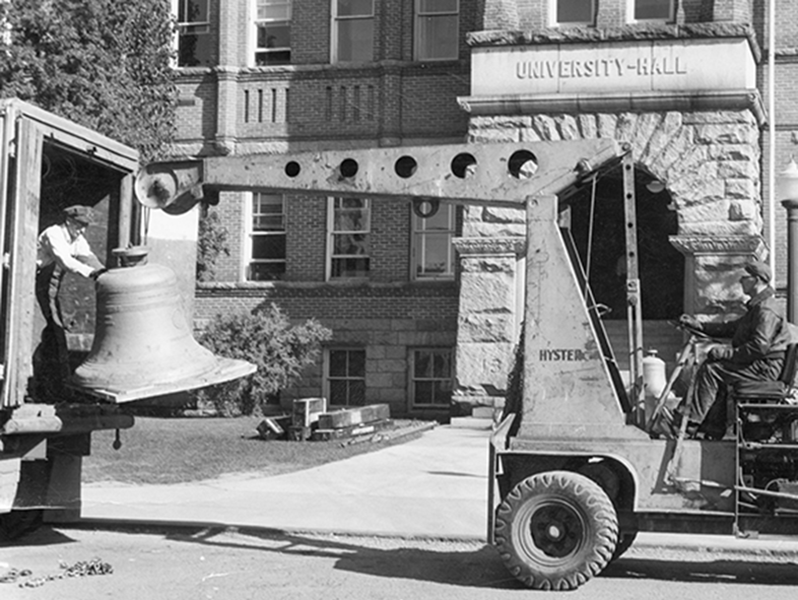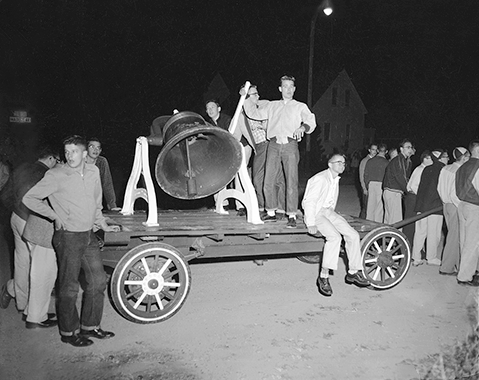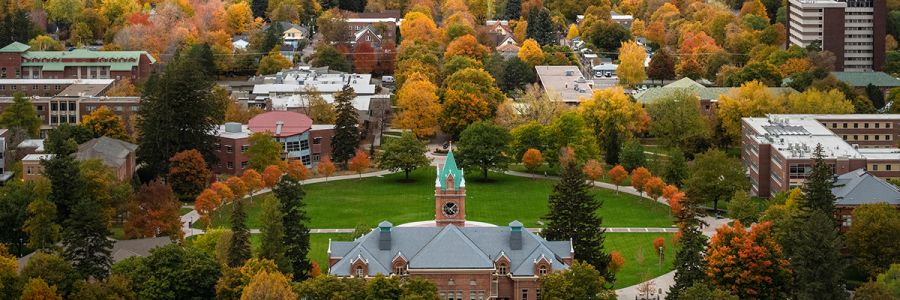Investing in Minds, Enriching Futures
UM Foundation Trustees and donors expanded scholarships and campus innovation during the 1950s
April 17, 2025
This story is part of “75 Years of Impact,” a celebration marking the University of Montana Foundation’s 75th anniversary. Throughout the year the Foundation will share stories illustrating the profound impact of donors’ philanthropy at the University of Montana across the decades. To learn more visit SupportUM.org/UMF-75.
The early 1950s were boom times in America.
Montana — like much of the nation — was rapidly modernizing, buoyed by economic expansion in the wake of World War II. After experiencing the biggest enrollment drop in the University of Montana’s history during the war, student numbers at the University surged as much as 79% from 1944-46.
Yet at the time of the University of Montana Foundation’s inception on November 18, 1950, uncertainty still loomed.
The Korean War had begun five months earlier, and during the next five years, 6.8 million Americans — most of them young, college-aged adults — would serve overseas. Educational costs were rising nationwide, and as those servicemen and women began returning home, the need to secure the future of public higher education for all students became even more urgent.
In response, the Foundation’s Board of Trustees and pioneering donors, many of them former UM students themselves, moved quickly to address the challenges. They understood firsthand that an empowered student body and dedicated faculty were the lifeblood of UM. Throughout the ’50s, the Foundation’s top priority became delivering high-quality, accessible education for the nation’s "young intellects," as it described aspiring undergraduate students at the time.
“Never in all history has such emphasis been placed upon the need to educate these students,” the Foundation wrote in an early message to donors. “Increasing costs have prevented some outstanding minds from completing their college degrees. These are great and growing needs, and we neglect them at our own peril."
Investing in the Future: The Early Days of Student Support
By 1952, the Foundation was facilitating gifts for at least 11 different colleges and programs. All gifts not earmarked by donors for specific purposes supported student scholarships. By 1954, initiatives like The Worthy Scholars Program were underway to help students navigate their journeys through higher education.
Financed in part through a $25,000 anonymous endowment, the scholarships were awarded on a competitive basis to graduating Montana high school seniors. Students showed up by the hundreds to take special exams to qualify for them.
The Foundation referred to this initial scholarship push as its “Investment in Minds.” In 1957, donors stepped forward to provide 24 graduating high school seniors from Montana with full tuition scholarships.
Aside from The Worthy Scholars Program, the Foundation supported around 30 additional funds and fostered several other scholarship efforts during this period — a preview of the giving community’s priority for the next decades and to today.
During this period, the organization also began to receive donor support from corporations and other business entities, as well as planned gifts in the form of bequests and life insurance benefits.
To raise additional money for athletic scholarships, donors created the Century Club in 1955. By 1958 the group had 200 members, who each paid $100 per year to support Grizzly sports teams.
In addition, the early ’50s saw the formation of the President’s Fund, the forerunner to today’s Excellence Fund, a fund used at the president’s discretion to meet critical needs, fund dynamic initiatives and open doors to opportunity for all UM students.
From those modest beginnings to today, the Foundation continues to work with donors and UM to provide critical philanthropic support for students. For example, in academic year 2023-2024 donor giving allowed UM to distribute $6.8 million in student support, including 3,086 donor-funded scholarship awards.
Enhancing UM’s Iconic and Innovative Facilities
Beyond student success initiatives, the Foundation also began to help unite donors around efforts to expand and better equip UM’s campus facilities during the early 1950s.
Among those initial measures was ensuring that the clock tower at University Hall (known colloquially as Main Hall) finally got its bells.

Architect A.J. Gibson specifically designed the tower to house a carillon, a large keyboard musical instrument which uses an intricate system of differently sized bells to produce melodies. But for decades after its completion in 1897-98, Main Hall only had a single bell — the comparatively small “victory bell,” which tolled the hour and rang after Grizzly athletic victories.
By the end of 1951, Foundation Trustees had set their sights on a 47 bronze-bell carillon cast by the renowned Royal van Bergen Bell Foundries in Holland. In just shy of two years, a coalition of individuals, families, alumni, faculty and organizations raised nearly $16,000 to buy it.

The carillon was installed in Main Hall by H.T. van Bergen himself, and was dedicated during Homecoming, on Oct. 18, 1953.
The carillon’s two biggest bells were sponsored by the UM Alumni Association and the Associated Students of UM, respectively. The original victory bell was ultimately relocated to Washington-Grizzly Stadium, where it still rings after Grizzly football wins.

As of 2025, the carillon’s largest bell can be heard across campus and Missoula neighborhoods as the clock marks the hour and half hour. Its booming toll has become an iconic part of the UM campus experience.
The carillon itself is still played during noontime concerts, during UM Homecoming "yell night" celebrations and at Commencement.
Each bell is dedicated in memory or in honor of a loved one, many of whom gave their lives for our country. Plaques detailing the dedications hang outside the main entrance to Main Hall.
Among the many other UM campus needs and opportunities identified as funding priorities throughout the 1950s were securing private support needed to purchase a new pipe organ for the music department as well as helping UM open the Frederick C. Scheuch Planetarium, which operated until 1968 in the small brick building east of Craig Hall that now houses UM’s Global Engagement Office.
Many of the gifts for these upgrades came from sources who were lending support to UM for the first time. Their willingness to unite to foster community and improve campus life planted the seed from which the University’s legacy of giving would grow
A Decade of Volunteerism
Records indicate that the first person to draw a paycheck from the Foundation was likely Tomme Lu Middleton, the Board’s executive secretary, who received a one-time bonus in 1957 for her work on the organization’s initial fundraising efforts.
Prior to that, however, all work done on behalf of the Foundation and its donors was carried out on a purely voluntary basis.
Initiatives of the 1950s, like The Worthy Scholars program and the Memorial Carillon, ushered in a decade of selfless volunteerism by Foundation leadership. This group of dedicated private citizens came from across Montana to contribute their time, united around a grassroots mission to fund crucial needs for UM and its students.
Their early generosity would exemplify an enterprising spirit that would carry campus through the next 75 years. Three quarters of a century later, those original values still underpin the Foundation’s work. Though today the numbers are larger and the methods more sophisticated, the Foundation and its donors continue to “invest in minds,” and to uplift “young intellects.”
That first paycheck paid to Middleton is a fun footnote in the Foundation’s history but was also a sign of its rapid evolution throughout the 1950s. It represented the desire of the Trustees to get even more work done. Skilled people were needed to expand its reach and focus on special projects.
As the decade concluded, the Foundation’s total assets had grown from $2,155 in 1951 to nearly $150,000 by 1959, a sum that equates to about $1.6 million today.
The public-private partnership between UM and its donors through the UM Foundation was already on its way to becoming a powerful force, which would impact the lives of generations of students and their communities.
Just as they did then, the University’s supporters still think big about the future, guaranteeing that UM will continue to enhance its status as a world-class institution that boldly provides life-changing educational opportunities and cutting-edge training to the leaders of tomorrow.
To learn more about the Foundation’s 75th anniversary and read feature stories spanning the decades, please visit SupportUM.org/UMF-75.
The information on this website was compiled from a variety of sources, including records held by the UM Foundation and the Maureen and Mike Mansfield Library Archives and Special Collections. The UM Foundation has made its best efforts to provide an accurate representation of events, people, entities, names, activities and data. However, the information presented should not be considered a definitive historical record.
